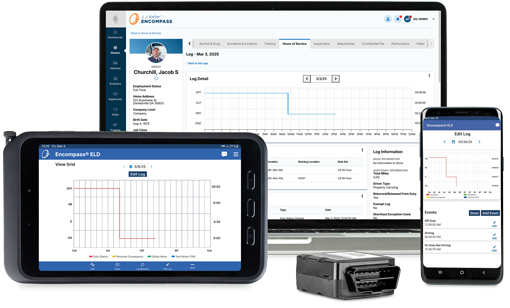Sr. Transportation Management Editor — J. J. Keller & Associates, Inc.
3 Ways to Use ELDs to Improve Driver Performance
Improving the performance of your drivers is one way to improve your bottom line. Easy to say, hard to do.
Published On: 09/07/2018


Written by:
Mark Schedler
Business is good, but drivers are scarce. Where can you find more capacity without offering $7,000 or more in sign-on bonuses? How can you improve the bottom-line profitability without raising prices and increasing risk?
Improving the performance of your current drivers is one way to improve your bottom line. Easy to say, harder to do. To help you maximize the results of your operation in the age of electronic performance monitoring — and the accompanying landslide of data — developing an effective driver performance assessment and management process provides leverage to do more with the team you have.
You can improve results and reduce risk using electronic log data in three important ways:
- Target the riskiest driver behaviors first
- Attack inefficiency and improve service
- Improve retention with coaching, recognition and rewards
Target the Riskiest Behaviors First
Targeting risky driving and compliance behavior is a top priority. The benefits to the bottom line are obvious — all costs avoided by reducing accidents and violations falls to bottom-line profits
A performance management system, with targeted reporting, helps identify the riskiest drivers that must be coached and/or trained. And targeting risky drivers instead of “lecturing” the whole group prevents alienating good drivers who can skip the training and drive.
To keep it simple, a few key areas that correlate to crash risk are:
- Excessive speed – accumulated time and speeding events
- Hard-braking and distracted-driving event trends
- Previous safety incidents including non-reportable accidents
- Log falsification incidents and recurring limits violations
Repeat offenders of your safety standards should have a very clear progressive discipline plan that communicates that the individuals must eliminate the risky behavior or find another job.
You can find details on reports to look for and how to address even more areas of risk in "The Power of Driver Performance Management – 5 Keys to Improving Results and Reducing Risk."
Attack Inefficiency & Improve Service
Since ELDs are connected to a truck’s engine control module (ECM) and have global positioning system (GPS) data, your investment in an electronic logging system can generate even more dividends. Reports that identify opportunities to increase productivity and ultimately improve profitability allow you to generate more revenue and/or profit with the same number of drivers.
Opportunities for the more efficient use of resources can be identified in reports on high leverage items such as:
- Excessive customer delays
- Automated IFTA reporting
- Fuel efficiency
Let’s take a closer look.
EXCESSIVE CUSTOMER DELAYS
In this era of limited truck capacity and driver shortages, there’s a significant incentive for shippers and carriers to collaborate on reducing excessive loading and unloading delays. Using ELD data and additional technology, delays above the contractual threshold (2 hours, for example) will generate increased detention billing, and more importantly, support problem solving to allow drivers to haul more freight.
But excessive customer delays rob you of capacity and can cause drivers to look for employment elsewhere. Consider this: Service and revenue generation improve when a driver’s available hours of service are predictable, and when drivers aren’t continually held up. The driver can make roughly $12- 15 per hour in detention pay for every hour delayed after 1-2 hours, but he/she could instead be making $25-30 per hour driving and generate $80-100 per hour in revenue for the carrier. A reduction of one hour per week in driver-delay time can potentially increase revenue for the carrier by approximately $4,000 per year and $1,250 per driver.
AUTOMATED IFTA REPORTING
One of the easiest areas in which to achieve efficiency with electronic logs is in International Fuel Tax Agreement (IFTA) reporting. GPS-generated mileage by state can be used to automate IFTA reports to determine fuel taxes owed. The labor involved in reporting will be significantly reduced and accuracy will increase. And your drivers will be happier with paperwork responsibilities lifted from their daily task list.
Just make sure that the electronic logging system meets the GPS polling accuracy and frequency requirements for IFTA as well as other requirements. An ELD is only required to generate a location every 60 minutes while in operation and IFTA can require a location every 15 minutes or less. Another critical difference is that hours-of service records (electronic and paper) must be retained for a minimum of six months while IFTA records are to be kept up to 6.5 years.
FUEL EFFICIENCY
Eliminating excessive-idle time generates significant savings. Idling a standard sleeper-berth equipped big rig consumes roughly one gallon of fuel per hour if the vehicle is not equipped with an auxiliary power unit. Idling for an eight-hour sleep period can burn $20 per night, which is over $100 per week.
Two additional reports to identify possible improvements in fuel efficiency are:
- Excessive-speed trend reports by driver and real-time speed alerts, and
- Drivers consistently exceeding optimal revolutions-per minute(RPM).
Not only does reducing excessive-speed events enhance safety, but the Environmental Protection Agency (EPA) has found that driving 65 mph instead of 55 mph can consume up to 20% more fuel. Also, the EPA determined that driving at excessive RPM can waste several gallons of fuel each hour.
Improve retention with coaching, recognition and rewards
Recognition and reward programs, combined with a solid performance management process, helps in minimizing unintended turnover of your safest, most dependable and productive drivers. Moving individuals from unacceptable or marginal performance levels to “keepers” can reduce turnover and the associated cost of employee churn, keep trucks moving efficiently, and decrease potential liability. And who doesn’t want that?
Be sure to take a close look. Your “good drivers” who run high miles may represent your highest risk for negligent supervision. Balanced performance management reporting allows your team to see the true value and risk of each driver.
The benefits of recognizing and coaching drivers won’t last without ongoing monitoring of behaviors. Don’t confuse dependability with loyalty, as good performers also need to feel appreciated by management on an ongoing basis, just as lower performers need to be coached and trained.
Driver scorecards are an integral tool to recognize positive behaviors and draw attention to negative ones. The scorecard is also a way to promote friendly competition, reward cost saving and safe behavior, and sustain continuous improvement as a keystone of the company culture.
Get additional ways to improve results and reduce risk plus more details on each area presented here by downloading The Power of Driver Performance Management – 5 Keys to Improving Results and Reducing Risk.
You may also enjoy the following articles:
Sign up for our newsletter!
We'll help you stay on top of regulations, best practices, and fleet industry news. Sign up to receive a monthly email notification with links to our most recent blog articles, free resources, and event invites.
